

AN S3 UNIVERSE
Several years ago, I developed an interesting idea about which could
be our Universe shape. I was very interested in study the implications
of considering the Universe to be a 3 dimensions Sphere, that means, an
S3 topology. Briefly, this consideration could make us understand why there
are filamentary structures, and a reason for the strange astrophysics discoveries
of Halton Arp.
1.- What is an S3 shape?
Before answer to this question I am going to explain what are the S1 and
S2 shapes, ok?
- An S1 Shape:
A straight line is a one dimension space. If we were living in a space
like this, we could only go forward or backward, but could travel in one
of these ways as much as we wanted, because we wouldn't find a limit.
Now, suppose we cut this straight line in such a way we got a finite
segment. and we join the two edges. Then, we will have obtain a circumference.
If we regard this circumference as a space, it will have similar properties
to the straight line. The only difference will be that when we had travel
for a while, we will have arrived to the starting point. This is call an
S1 shape, in Mathematics.
- An S2 Shape:
To imagine an S2 space, we have to regard a sphere surface as a space
in which we can move. We live in the World, and this is just a big S2 space.
We know that in short distances the world is like a plane surface: we can
move forward, backward, left and right. So we have 2 dimensions, hence
this shape is called S2 in Mathematics. We can observe an important detail
in this S2 world: if we walk enough distance in a given way, we will return
to the starting point. We will have gone round the World.
- An S3 Shape:
Our (or at least mine) space feeling doesn't let us to imagine an S3
space seen from the outside, like in the S1 and S2 spaces. As we live in
a 3 dimensional space we can see and imagine infinite objects of 2 and
1 dimensions, because our space can contain them. This doesn't happens
with infinite 3 dimensions shapes.
So, the only way for our mind to understand what is a S3 shape is to
go inside it (with our imagination) and study its properties:
-
We can move in three different ways (up and down, left and right, forward
and backwards), so it is a 3 dimensions space.
-
We will return to the starting point if we walk enough, and doesn't matter
the way we took.
2.- What does an S3 Universe involve?
Now that we know what an S3 Universe is, the next question is that if our
Universe had this shape, what would be the facts we would observe. Go on
reading to get the answer.
Let imagine a star located at some place inside this S3 space. This
star will through light radially, all around itself. If I take my attention
to a particular ray of light of this star, I will realize that some time
later this ray will arrive to the same point it had started this way round
the S3 Universe.
This will happen to every ray emitted by the star, in every direction.
So absolutely all the light emitted at the beginning from the star will
return to this same star, some time ago.
There is another important fact: The light of the star, before arriving
to the starting point (to be exact, at the middle of the way), will concentrate
in a point due to the "sphereness" of the S3 Universe. Look at Picture
1.
On the other hand, the star light concentrates again on the other edge
of the S3 Universe (You may see this light ray convergence in the Picture
1. This drawing represents an S2 Universe, but an S3 is very similar).
So, what will I observe?
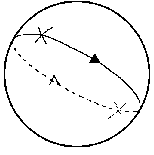 Picture 1: Two rays in the S2
Picture 1: Two rays in the S2
The observer will see a star throwing light and later (this depends
upon the Universe scale) he will see a mirror image of this star where
it was located before (supposing it is moving).
So, he will observe two stars (one of them is merely a mirror of the
first one). If we wait enough, there will appear more mirrors of this star,
forming a straight line, and at distances that depend on the Universe scale
and the velocity of the star. Of course there will be another mirror (or
if you wait enough, mirrors) in the opposite edge of the S3 Universe. This
is this way because the star light is traveling constantly round the Universe
Hence, we already have the first result: There will be multiple images
of the illuminated objects of the Universe.
On the other hand, I may consider if this phenomena, we have studied
with the light rays, could be experienced with the interactions (the forces).
If we regard gravitation like an interchange of particles (you know, gravitons),
these particles will run through their trajectories in the Universe, starting
from the star that threw them like the light rays. This is due to the mass
of the star, that is gravitationally interacting.
So, gravitons, as everything that travels through the Universe, will
have to run over closed trajectories, that is, coming to the starting point,
like light rays do. The conclusion is that we will sense the gravity of
the star image (not the real star), in the same way that we will see the
star image. Hence, if the generated image of the star would be perfect
(that involves a symmetric universe with no fluctuations, and that may
not be the case), we will sense all the star light and interactions like
if it were a real star. We couldn't difference it from a real star.
So, the second conclusion is: The image star will interact like if
it were a real star..
Why do I think this model is correct?
The most important reasons to think that a theoretical model is correct
are the confrontation between theory and empirical data. In this case,
the empirical data are the Universe observations. Let's talk about that:
As it is known, in the large scale Universe, it may be seen strange structures
of galaxies and galaxy clusters. Great voids of galaxies are found between
other zones plenty of them. It may be appreciate the galaxies form filamentary
structures.
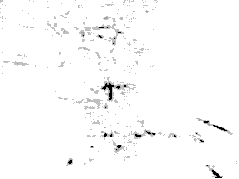 Picture 2: Representation of galaxies obtained from real data.
Picture 2: Representation of galaxies obtained from real data.
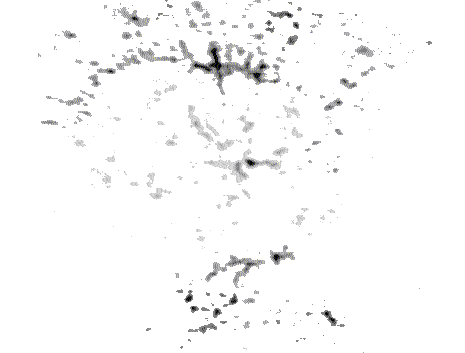 Picture 3: Detail in the galaxy map representation.
Picture 3: Detail in the galaxy map representation.
Let's have a look to three graphics of the filamentary structures in
the Universe (Pictures 2, 3, and 4). If we look graphics from other sources,
we will find the same main features, that I will describe later. These
graphics have been obtained from many observations of the extra galactic
space. They are plane sections of the Universe and we are located in the
middle of the pictures 2 and 3, meanwhile in the picture number 4 we are
located in the lower edge (the sector vertice). The quality of the pictures
2 and 3 is much lower than picture 4, so in these figures you can't resolve
every galaxy as a point in the sector, meanwhile in picture 4 you can do
it. The advantage of pictures 2 and 3 is that they show the complete sector,
but picture 4 shows only the upper extra galactic visible zone.
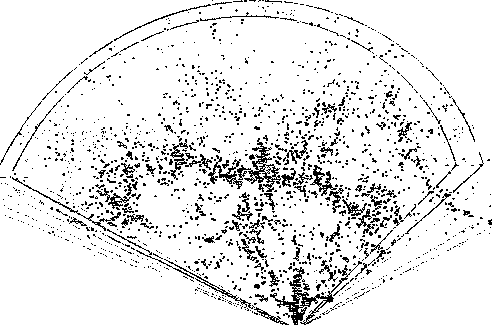 Picture 4: Angular representation of the galaxy distribution.
Picture 4: Angular representation of the galaxy distribution.
These structures are featured by:
-
Great Wall: This is the name given to the arc shape structure round
our position (Picture 5). If it has an arc shape and not a complete circumference
shape it is due to (supposition of the author) there is a big area in the
sky where we can't observe extra galactic objects (Great Wall is one of
these) because our own galaxy is in the middle of the field of vision.
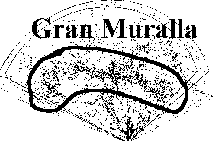 Picture 5: Great Wall
Picture 5: Great Wall
So, we may think that the Great Wall is not really an arc, but a complete
circumference (Picture 9). If we make this assumption, we will realize
that curiously the center of the circumference is exactly where we are,
in our galaxy cluster, that is, the observer position (Picture 7).
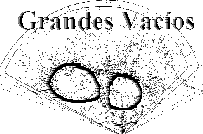 Picture 6: Great Voids
Picture 6: Great Voids
We are studying sections of the Universe, but not this one as a whole.
So, is normal to think that what is a circumference in a plane surface,
will be an sphere in a cubic space (a 3D space). We know the space of our
Universe has three dimensions, like the cubic space. Hence, the Great Wall
might be a complete sphere around us (and our galaxy just in the center,
What a curiosity!). Later, when we apply the S3 model of the Universe,
we will realize that this effect doesn't mean that we are in the center
of the Universe, but every observer will see the same effect everywhere
he was located in the Universe.
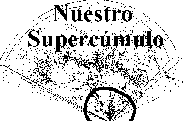 Picture 7: Our Super cluster
Picture 7: Our Super cluster
-
We observe that crossing with the Great Wall there are filamentary structures
(Picture 8) that curiously are pointing to us (the observers). We also
see that Great Wall is really a wide band radially stratified. That means
it is composed by a lot of fine structures pointing to us (Picture 10).
-
Great Voids (Picture 6) are distributed around the Great Wall (Picture
5) and the galaxy cluster where our galaxy is found (Picture 7).
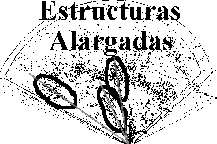 Picture 8: Thin Structures
Picture 8: Thin Structures
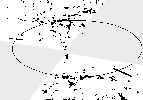 Picture 9: Light Way is hiding some filamentary structures
Picture 9: Light Way is hiding some filamentary structures
These are the experimental facts in relation with the filamentary structures.
It is needed an explanation, and I think it is the following:
It is not difficult to understand that if we live in an S3 Universe
and observe a zone on the other edge of the Universe, we will see it in
every direction we look at. So it will be all around us. If we thought
our space was flat, we would think that this zone is a big surface that
is rounding us, and is centered on us. If, against this idea, we thought
that our Universe is an S3 one, we would understand as a logic phenomena
this experimental fact, and the only reason to explain why we are the center
of this structure is because we are the observers.
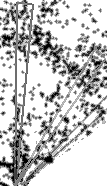 Picture 10: Zoomed image in which we can observe the stratified
filamentary structures
Picture 10: Zoomed image in which we can observe the stratified
filamentary structures
When we make a stereo graphic projection, what we actually are making
is represent an spherical space S2 as if it were a flat space. A World
map is a stereo graphic projection of the World, and this makes the shape
of the Antarctic to appear distorted. If this maps showed beyond Antarctic,
you know, Australia and so on (respect Europe), we will observe those regions
much more distorted than Antarctic. It will appear like a circular region
rounding us, (I mean Europe). This is due to the fact that the other edge
of the world is equally distant from us in every direction.
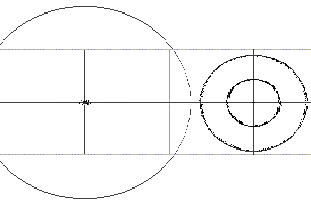 Picture 11: An structure image projection forming a wall.
Picture 11: An structure image projection forming a wall.
If we go on showing beyond in the World map till reach again our own
location, we would obtain that the region in which we are will have also
a circumference shape with the same center that the first one, but with
a double ratio. Is also logical because we can reach our initial location
going to every direction making a World round. In the S3 space the same
happens, but with one difference, there will be a sphere instead of a circumference.
So, if we suppose our Universe to be an S3 space, we would have a clear
explanation of the suspicious spherical shape of the Great Wall centered
on us. It will be the result of our own image after taken a full round
to the Universe. Look at Figure 11: On the left side, we find a galaxy
cluster centered on image. We are supposed to be in the center of the cluster.
On the right side, we have the stereo graphic projection of the left image,
supposing an S3 Universe. On the right side output image two Great Walls
are shown. Actually an infinite number of then should have been obtained.
I'm drawing only the two firsts Great Walls. In the experimental observations
we can only see the first one. This picture is a computer simulation of
the S3 projection applied to a random cluster shape. As the Great Wall
is about 400 million light years from us, this would be the S3 Universe
perimeter.
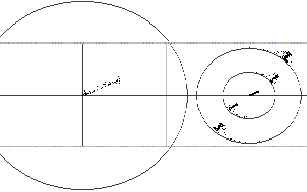 Picture 12: Cluster shape mirrored
Picture 12: Cluster shape mirrored
Experimentally, we see that the Great Wall is an ellipsoid around us.
This is explainable if we make the assumption that our Universe is an non-perfect
S3 shape. We find the same case in the World Map. The Earth is not a perfect
sphere, but an ellipsoid. So, the distance of a world round going to the
Poles is less than going to the Equatorial zone. This effect is making
that the circumference shape of the Great Wall turn to be an ellipse shape.
So, the fact that the Great Wall is an ellipsoid is not difficult to explain.
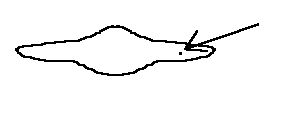 Picture 13: Our location in our Galaxy
Picture 13: Our location in our Galaxy
We have found there are filamentary structures with radial symmetry.
Radial symmetry has a deep relation with spherical symmetry. So it mustn't
be difficult to explain this effect if we suppose an S3 Universe that has
a clear spherical symmetry.
If we make an stereo graphic projection of a plane shape similar to
the Picture 13, we obtain the famous radial filaments. But the question
is why our galaxy cluster has this strange shape? The answer is based on
our Galaxy shape. Stars in the galaxy group make a big cluster, called
Galaxy. In the same way, galaxies do the same, forming galaxy clusters.
The physics that controls the shape of these groups is the same, but with
another scale factor. So the resulting group shape might be similar. Pictures
14a and b show two images of the experimental observations of our galaxy
cluster shape. 14a is a picture obtained from picture 2, and 14b from 3.
  Picture 14a and b: Our closest galaxy cluster shape.
Picture 14a and b: Our closest galaxy cluster shape.
The following fact to explain are the Great Voids. The images of the
low density regions of our own Galaxy Cluster and close regions are the
Great Voids. They exist just because there are long radial filamentary
structures and a Great Wall.
To finish with the Filamentary Structures subject, I have made an stereo
graphic projection of the image experimentally obtained of our galaxy cluster
(Pictures 14a, 14b and 15). Besides the projection itself, I have considered
a rotating movement of our galaxy cluster, so as to radial structures were
aligned exactly like experimentally are observed. If we calculate the angular
velocity considered for the structures to match, we will obtain that they
would take 14400 millions of years to turn 360 degrees. This stereo graphic
projection matches with the experimental maps of our surrounding galaxies
(Pictures 15 vs 3, 4 and 5). Nevertheless the matching is not exact due
to the next reasons:
-
The stereo graphic projection we observe experimentally does not come from
the shape of our galaxy cluster as we observe today, but its shape 400
million years ago. I am supposing that its shape has not deeply changed.
However, it is natural to think this shape has changed, at least, a bit.
This changes are contributing to the mismatch between the theoretical and
the experimental galaxy patterns.
-
I do not have enough information of our galaxy cluster shape. (Look at
the differences between the image is going to be projected in the picture
15 and that of the pictures 14a and 14b).
-
In the simulated projection has not been considered that our S3 Universe
may not be a perfect S3 sphere. If it were not a symmetric S3, as the Earth
is not an exact sphere, the projection would be different.
-
Another limitation of this projection is that it has been supposed that
the Universe is turning around the perpendicular axis and that is surely
not true. In that case we have another reason to understand the mismatch
previously commented.
The conclusion is that if we made a better projection considering all this
facts, we could obtain a simulated galaxy pattern matching much better
to the experimental pattern. On the other hand, we would have obtained
important parameters describing our Universe rotating movement: angular
velocities, rotation axis, ...
All the previously exposed points lead us to a very important possibility
to explain the nature of the Filamentary Structures, the Great Wall and
the Great Voids.
Experimentally, astronomers have found several groups of galaxies in which
we observe some of them are interacting forming gravitational bridges of
matter, or any other kind of details that give us good reasons to think
that they are close one from another and form a galaxy family. Nevertheless,
when astronomers measure the distance between these galaxies they find
that they are very far one from another, and that is not explainable (Look
at the book "Quasars and Red Shift Controversies" written by Halton Arp).
If we think again in the S3 Universe model, we may realize that coming
from a given galaxy, we receive not only its direct light, but we also
receive the light of the image that has been generated on the other edge
of the S3 Universe, and the light of the image generated on the initial
position (when the light has turned one complete round to the S3 Universe),
and so on. If we measured the distances between these images we would obtain
the half perimeter of the S3 Universe and its multiples, because the light
has turn around the Universe completing first half round, later one round
and so on. It is important to understand that astronomers measures the
galaxy distance with the Red-Shift method. This means, that they are not
directly measuring the real distance, but the the time that the light coming
from the galaxy has taken to arrive to the Earth.
If we suppose that the original galaxy is not moving, we will obtain
images of this galaxy in the same position that the galaxy was originally
located. If it were moving, the original galaxy would appear distant from
its image. The conclusion is that we will observe in the general case (that
is considering that all the galaxies are moving) a group of similar galaxies.
Actually, they are the same, but with a 400 million years of evolution
of difference.
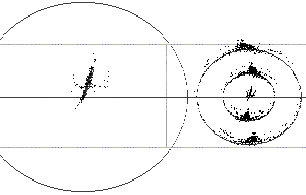 Picture 15: Projection simulation results.
Picture 15: Projection simulation results.
In brief:
-
There will appear groups of galaxies.
-
Them all will be very similar (actually we will be seeing the original
galaxy and its images 400 million years ago or more)
-
They will be aligned (this will be true only if the galaxy is free to
move on their own. If it was under a gravitation field, its trajectory
wouldn't be linear)
-
There will be great differences in the red-shift between them.
-
There may be gravitational bridges between them (it is natural, considering
that the image also interacts with other galaxies gravitationally)
-
All them will be of similar size (the fact that the light that forms
the image turns around the Universe one round doesn't mean it is going
to be seen smaller due to the distance, because the image formed is like
the original galaxy and is at the same distance).
All these phenomena can be experimentally observed in our Universe.
There are many examples. For example we have the Stephans Quintet galaxies.
All these groups of galaxies show anomalies, that were unexplainable, until
now.
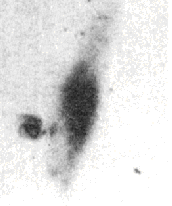 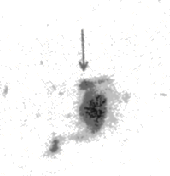 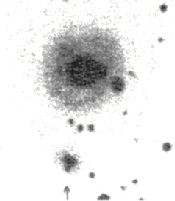 Picture 16: Interacting galaxies through gravity.
Curious alignments among quasars and galaxies have been observed. Quasars
nature isn't understood very well. They are too bright and too distance,
becoming unexplainable. All these kind of facts may explain if we think
of an S3 Universe.
Picture 16: Interacting galaxies through gravity.
Curious alignments among quasars and galaxies have been observed. Quasars
nature isn't understood very well. They are too bright and too distance,
becoming unexplainable. All these kind of facts may explain if we think
of an S3 Universe.
Remembering that with an S3 Universe galaxies produces several images
of themselves, is logical to think that the very old images will have such
a red shifted spectrums that almost their whole emission will be centered
in the radio waves (these waves are under the red in the frequency scale).
On the other hand, we must receive low radiation in the visible range from
these images, because all this emission should become from the UltraViolet
or X-Ray radiation from the original galaxy, and that uses to be of low
intensity. Hence, the whole spectrum received must be as intense as the
one emitted originally, but shifted to the red until become centered on
the radio wave frequency.
Respect to the quasar problem of being too distant to be so bright,
if we suppose an S3 Universe, we could say that all the light emitted originally
by this quasar has not been lost in the deep space, because the trajectories
of all these light rays converge in the quasar image every time they complete
half round to the S3 Universe. If the light never loses they will conserve
their light through the apparent big distance.
Another fact hard to explain now a days is the observation of fast movements
in the quasars structure or between neighbors. So fast that they move over
the light speed. Now, in the S3 Universe this phenomena is very easy to
explain, just taken account of that the real distance to the galaxy image
is not the distance measured with the red shift method (this last one would
be the distance from the original quasar to the Earth considering a plane
Universe), but it is a much shorter one. The scale would become much smaller,
and the velocities would also be smaller.
Taking account of the multiple images generated by quasars in the S3
Universe, astronomers would have to experimentally observe very interesting
relations and alignments between quasars and galaxies. Some examples are:
-
The most bright quasar with visible spectrum is 3C273, in the Virgo constellation.
It has got a very big jet. Near in the sky, around 10º to the North,
we may find the M87 galaxy. This one is a special galaxy, because it emits
high intensity in radio waves, and it has a jet, similar to the 3C273 jet,
and they are oriented almost in the same direction. Near from these two
objects, a very big intergalactic nebula was discovered several years ago.
It has also a liner shape oriented in the same direction that the M87 and
3C273 jets.
-
If we observe NGC 300 we will appreciate that, near this galaxy there are
hydrogen clouds with some type of alignment and very near we find a line
of quasars. The direction of the line of quasars is not very different
of the clouds (Picture 16).
-
Near M33, we find hydrogen clouds, and another line of quasars (Picture
17).
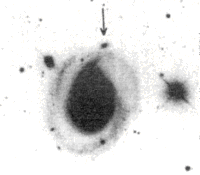 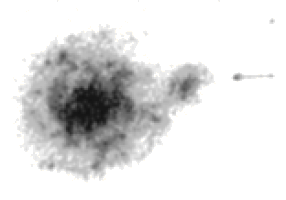 Picture 17: Galaxies with anomalies
Picture 17: Galaxies with anomalies
Serious science needs experimental confrontation of the facts that the
model or theory predicts. Until now, this is what we have been doing: to
develop the model (finding out the consequences of supposing an S3 Universe)
and confront it with experimental observations (similarities in the Universe
map, red shift and quasar phenomena, ...).
Now, we may expose another kind of reasons to think that the Universe
is an S3. These are philosophical reasons. When I developed this S3 model,
I had only philosophical reasons to believe in it. After developing it,
I found experimental data fixing with the model results. So, it may be
interesting to study these philosophical reasons:
Why do I have to think the Universe is closed?
There is a very short answer: "So as the Universe not to be infinite".
At first, we may not understand why it is necessary the Universe to be
finite. If the Universe were infinite in space, we never would be able
to know it completely, unless it were cyclic. In that case, we would have
a closed Universe (such as the S3). Physics tell us that nature also doesn't
like infinities in the description of nature: just think about quantification.
Quantification is limiting infinitesimal values so as not to be as small
as we want: quantum numbers uses to be natural numbers. These means quantification
is limiting physical magnitudes by the lower side. An S3 Universe would
be limiting magnitudes by a higher side. Another example of limitation
is Relativity: the speed of light.
Why the Universe has to be an S3 and not another kind
of closed shape in 3D?
There are two reasons:
First, our Universe has to be locally flat, because that
is what we observe. S3 is not the only shape that is locally flat, but
that reason is limiting the number of shapes to choose.
Second, in Nature is usual to find spherical symmetry
in much more cases than any other symmetry. It is important to use a shape
with symmetry, because the symmetry is giving us a theory with fewer parameters.
If we had, for example, a cylindrical symmetry we would have to explain
why the symmetry axis is pointing where it is and not to another direction.
I have always said that Physics is built over two principles: The
Principle of "Finiteness" and The Principle of Simplicity.
The first one says that every magnitude never reach Infinite and is
discrete (that is, it may only increase by multiples of an elementary unit).
The second one says that Universe must be as simple as possible, because
if it were not simple, that would mean that we would need extra parameters
to describe it globally, and the value of these parameters never would
be explained. The only way to explain the whole Universe in a complete
way is to suppose it is as simpler as possible.
These two principles imply the two last philosophical reasons for the
Universe to be an S3.
The End
To conclude the exposure of the Universe S3 model, I would like to remind
the reader that it is almost sure that there are other important conclusion
when you suppose the Universe is an S3. For example, if we think in Quantum
Mechanics, a closed Universe is directly in relation with the existence
of magnetic mono poles.
On the other hand, supposing the Universe is an S3 we may create interesting
ideas, such as the next one: "The Andromeda Galaxy, that is very near from
our, and very similar, could be the image of our own galaxy, the Milky
Way, 400 million years ago. With a very powerful telescope or interferometric
techniques we would be able to locate the Solar System in that galaxy and
the Earth, and see our own past and evolution, or even go there. It's like
a time machine."
My only hope is that this model will be studied seriously by the scientific
community to conclude if it is correct or no.
Thank you for your attention.
Bibliography:
-
Easy to read:
-
"Historia del tiempo" by Stephen Hawking. Editorial Crítica.
-
"El sueño de Einstein" by Barry Parker. Editorial Cátedra.
-
Hard to read:
-
"En el confín del Universo: Cuásares" by Jorge Ruiz Morales.
Editorial Equipo Sirius.
-
"Controversias sobre las distancias cósmicas y los cuásares"
by Halton Arp. Editorial Tusquets.
-
"Macroestructuras del Universo: Cúmulos y Supercúmulos de
Galaxias" by Alberto Castro Tirado. Editorial Equipo Sirius.
-
"The New Physics" Edited by Paul Davis. Cambridge.
 


|